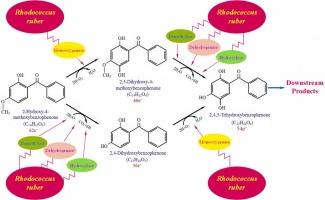How Rhodococcus ruber accelerated biodegradation of benzophenone-3
IF 12.2
1区 环境科学与生态学
Q1 ENGINEERING, ENVIRONMENTAL
引用次数: 0
Abstract
Benzophenone-3 (2-hydroxy-4-methoxybenzophenone, BP-3) poses risks to human health and natural ecosystems, and means to improve its biodegradation are necessary. When a small mass of Rhodococcus ruber, isolated from BP-3-acclimated biomass, was bioaugmented into the acclimated biomass, BP-3 removal was accelerated by 120%. The first step of BP-3 biodegradation generates either 2,5-dihydroxy-4-methoxybenzophenone (5-OH-BP-3) or benzophenone-1 (2,4-dihydoxybenzophenone, BP-1). BP-1 is generated by sequential demethylation, hydroxylation, and dehydrogenation reactions, while 5-OH-BP-3 is generated by one mono-oxygenation reaction. Of the two intermediates, 5-OH-BP-3 exhibited stronger inhibition than BP-1 or the original BP-3. Gene-completion mapping showed that R. ruber contains genes for demethylase, hydrolase, dehydrogenase, and mono-oxygenase reaction, which means that R. ruber could generate the less-toxic BP-1. Thus, bioaugmentation of R. ruber into BP-3-acclimated biomass eliminated the accumulation of 5-OH-BP-3 and, consequently, accelerated of BP-3 biodegradation via BP-1.

红葡萄球菌如何加速二苯甲酮-3 的生物降解
本文章由计算机程序翻译,如有差异,请以英文原文为准。
求助全文
约1分钟内获得全文
求助全文
来源期刊

Journal of Hazardous Materials
工程技术-工程:环境
CiteScore
25.40
自引率
5.90%
发文量
3059
审稿时长
58 days
期刊介绍:
The Journal of Hazardous Materials serves as a global platform for promoting cutting-edge research in the field of Environmental Science and Engineering. Our publication features a wide range of articles, including full-length research papers, review articles, and perspectives, with the aim of enhancing our understanding of the dangers and risks associated with various materials concerning public health and the environment. It is important to note that the term "environmental contaminants" refers specifically to substances that pose hazardous effects through contamination, while excluding those that do not have such impacts on the environment or human health. Moreover, we emphasize the distinction between wastes and hazardous materials in order to provide further clarity on the scope of the journal. We have a keen interest in exploring specific compounds and microbial agents that have adverse effects on the environment.
 求助内容:
求助内容: 应助结果提醒方式:
应助结果提醒方式:


